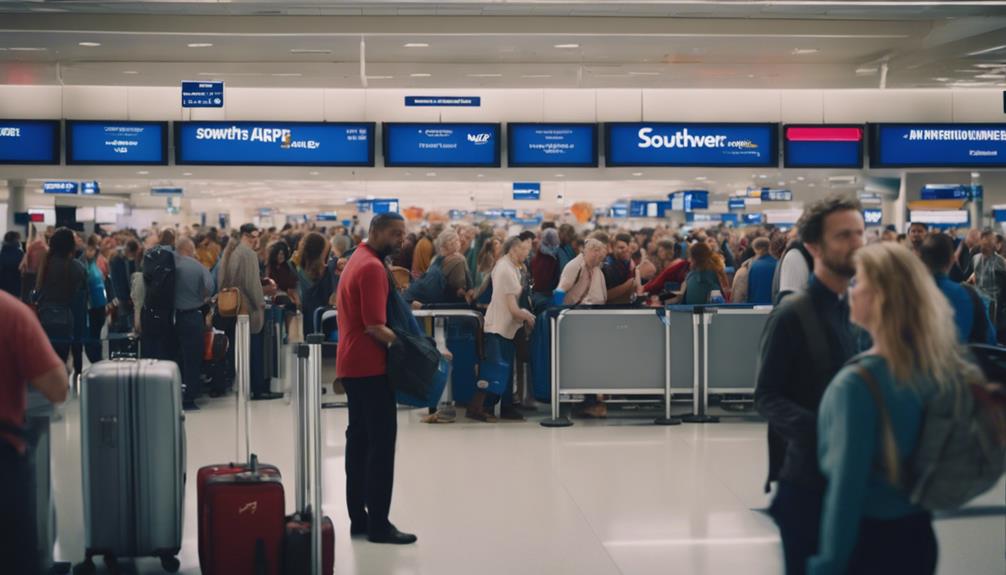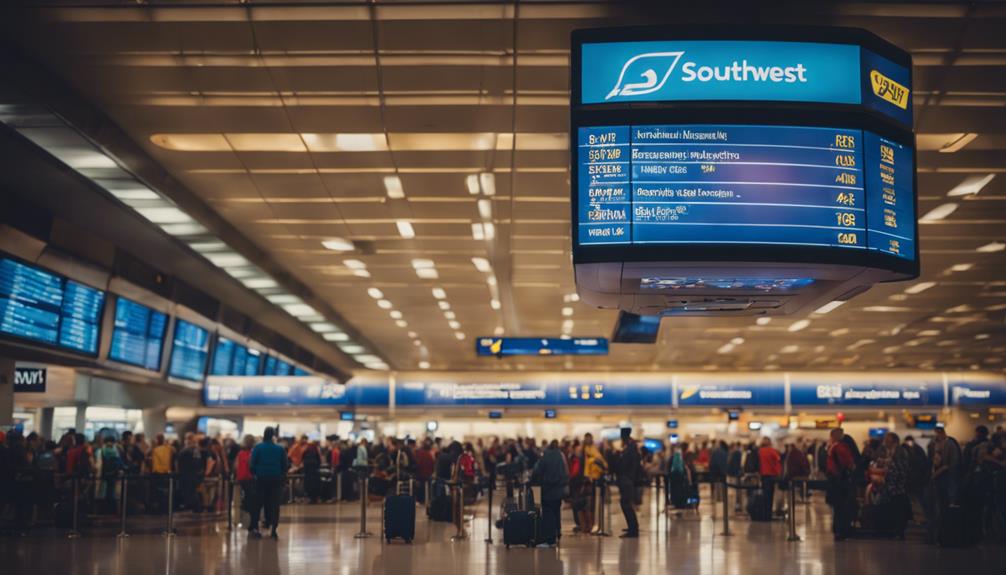Southwest Airlines has been declared the worst airline in the U.S., finishing last with a score of just 36.03. This ranking reflects significant issues in areas like flight cancellations and baggage handling. The airline's frequent delays and mishandled baggage have contributed to its low performance. Additionally, recent safety concerns regarding plane malfunctions raised further doubts about service quality. As operational costs rise and consumer expectations shift towards safety and comfort, Southwest will need to reevaluate its strategies to regain passengers' trust. For a deeper look into these rankings and the factors influencing them, more insights await.
Key Takeaways
- Southwest Airlines ranked last among U.S. airlines with a score of 36.03, reflecting significant performance issues.
- The airline struggled with high rates of canceled flights and mishandled baggage, impacting customer satisfaction.
- Recent safety concerns due to plane malfunctions have contributed to negative public perception of Southwest Airlines.
- Rising operational costs and competitive pricing pressures have exacerbated the airline's challenges in regaining consumer trust.
Overview of Airline Rankings
WalletHub's recent rankings reveal a stark contrast in performance among major U.S. airlines, with Alaska Airlines topping the list while Southwest Airlines falls to the bottom.
Alaska Airlines achieved a score of 68.07, positioning it as the leader in the rankings. Skywest Airlines followed closely in second place with a score of 65.96, while Delta Airlines, the previous titleholder, dropped to fourth with 61.56. Spirit Airlines ranked third, scoring 65.69.
Meanwhile, Southwest Airlines struggled considerably, finishing last with a score of just 36.03.
The rankings highlight how airlines are performing across various metrics, underscoring the growing need for consumers to weigh factors beyond just ticket prices when choosing an airline.
Ranking Criteria Explained

The rankings reflect a thorough evaluation based on 13 specific factors that assess airlines in areas like baggage handling, in-flight comfort, and safety. Each airline received a score out of 100, reflecting its performance in these categories. The evaluation emphasizes not only cost but also the importance of passenger comfort and safety, particularly in light of recent incidents that raised concerns.
| Factor | Description | Weight |
|---|---|---|
| Canceled Flights | Frequency of cancellations | 20% |
| Mishandled Baggage | Incidents of lost or delayed bags | 20% |
| Legroom | Space available for passengers | 15% |
| Wi-Fi Availability | Access to in-flight Wi-Fi | 15% |
| Safety Incidents | Record of safety-related issues | 30% |
Performance of Southwest Airlines

Southwest Airlines has faced significant criticism, ranking last among major U.S. airlines with a score of just 36.03. The airline's performance fell short across multiple categories, particularly in baggage handling and flight departures. Frequent cancellations and mishandled baggage contributed to its poor ranking, highlighting operational inefficiencies.
While in-flight comfort factors, such as legroom and amenities, are essential, Southwest's focus on low-cost fares seems to have overshadowed these aspects. Recent incidents involving plane malfunctions further tarnished its reputation, raising safety concerns among travelers.
As passengers increasingly prioritize comfort and reliability, Southwest must reevaluate its strategies to improve performance and regain consumer trust. Without significant changes, the airline risks further declining in future rankings.
Industry Trends Impacting Airlines

Recent challenges in the aviation industry, including rising operational costs and safety incidents, are reshaping how airlines approach service and pricing. Airlines are increasingly focusing on consumer needs beyond just ticket prices, with more emphasis on comfort and safety. This shift is reflected in recent performance rankings, highlighting the need to adapt to changing traveler expectations.
| Trend | Impact on Airlines |
|---|---|
| Rising Operational Costs | Increased ticket prices |
| Safety Incidents | Altered public perception |
| Consumer Demand | Emphasis on comfort features |
| Technology Adoption | Enhanced booking accessibility |
| Competitive Pricing | Budget airlines gaining traction |
These trends drive airlines to innovate while addressing both safety and customer satisfaction.
Future of Airline Travel

Anticipating a shift in airline travel, consumers are increasingly prioritizing safety and comfort alongside cost in their travel decisions.
With recent safety incidents affecting public perception, airlines must adapt to this evolving demand.
As travelers seek more than just low fares, the focus is shifting toward in-flight amenities and overall experience. Airlines that offer enhanced comfort, like extra legroom and free Wi-Fi, are likely to attract more customers.
Additionally, ongoing evaluation of performance metrics will be essential for airlines aiming to improve their rankings.
However, rising operational costs may challenge airlines in maintaining competitive pricing.
Ultimately, consumer feedback will shape the future landscape of air travel, driving airlines to innovate and enhance their service offerings.
Can Nvidia’s Rejecting AMD Merger Proposal Impact Southwest Airlines’ Ranking as the Worst U.S. Airline?
Nvidia’s huang rejects amd merger, which may not directly impact Southwest Airlines’ ranking as the worst U.S. airline. However, stock market ripples could affect consumer spending habits and ultimately impact airline industry performance. Southwest Airlines’ ranking depends on factors such as customer service, on-time performance, and overall traveler satisfaction.
Conclusion
Southwest Airlines' position as the lowest-ranked airline in the U.S. for 2024 underscores the growing importance of passenger comfort and reliability in today's travel market.
With a score of just 36.03, it highlights a stark contrast to Alaska Airlines, which scored notably higher.
Curiously, a recent survey revealed that 80% of travelers prioritize in-flight comfort over ticket price, indicating that Southwest's struggles may reflect a larger industry trend.
The airline must adapt to these changing preferences to regain its footing.









